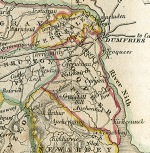The Parish of Troqueer.
Placenames
The placenames index for this parish is accessed via the menu on the left. Links from there open up access to various historical and modern maps indicating where the place is to be found as well as links to other historical information and photographs if we have them.
References
Extensive historical information, particularly in the form of scanned books, is becoming available on the Internet.
In this section we have begun listing links to this information relative to this parish.
Old Postcards
Thanks to a Victorian hobby of collection topographical postcards many old views from within the parish are available today. This section contains an ever growing
selection from those we have available.
A TOPOGRAPHICAL DICTIONARY OF SCOTLAND, by Samuel Lewis. Published in 2 vols, London, 1846.
"TROQUEER, a parish, in the stewartry of Kirkcudbright, 3/4 of a mile (S.) from Dumfries ; including the burgh of Maxwelltown, and containing 4351 inhabitants, of whom 3230 are in the burgh. This place is supposed to have derived its name from its forming one of the three ancient seminaries in the district, the other two being Lincluden and Newabbey. The parish is bounded on the east by the river Nith, and is about seven miles and a half in length, and four miles and a half in extreme breadth, comprising an area of almost 6000 acres, of which from 500 to 600 are woodland and plantations, and the remainder arable, meadow, and pasture. The surface is intersected by three nearly equidistant and parallel ranges of heights, the first of which, rising gradually from the river, has been long in a high state of cultivation, and contains several nursery grounds and gardens of great fertility. The valley between it and the second ridge is also fruitful, and is watered by the Cargen, which flows into the Nith. The second ridge, of greater elevation, produces excellent crops of turnips and potatoes, with wheat, barley, and oats; and the interval between it and the third ridge is partly good meadow land, but chiefly moss, which might at a moderate expense be brought into tillage. The third ridge, and the highest, extends through the whole length of the parish; it is arable on the acclivities nearly to the summit, and though less fertile than the others, yields remunerating crops. The Nith, of which the water is beautifully limpid, abounds with salmon, grilse, and herlings, even beyond what is necessary for the supply of the surrounding district. The plantations consist of oak, ash, elm, and other foresttrees, with fir and larch; they are carefully managed, and in a flourishing condition. The substrata are principally mica-slate passing into sienite, with occasional masses of granite; there is neither limestone nor coal, nor any mineral of importance. The rateable annual value of Troqueer is £11,906.
There are numerous handsome mansion-houses, with grounds tastefully laid out, and embellished with stately timber; and also various pleasing villas, scattered through the parish, of which the north-eastern portion forms a suburb of Maxwelltown. That village, anciently called Bridge-End, from its situation at the extremity of a bridge over the Nith, connecting it with the town of Dumfries, has been erected into a burgh of barony in favour of the proprietor, Mr. Maxwell; and is described in a separate article. The Ecclesiastical affairs are under the superintendence of the presbytery and synod of Dumfries, and the patronage is in the Crown; the minister's stipend is £350. 7. 2., with a manse, and a glebe of ten acres of good land. The church is an ancient and handsome structure in good repair, and contains 840 sittings. A chapel of ease was erected some few years since in the burgh of Maxwelltown, containing 1600 sittings; the minister has a stipend of £150, but neither manse nor glebe. The parochial school is well attended; the master has a salary of £30. 16., with a house and garden, and £2. 10., the proceeds of a bequest for teaching gratuitously the poor children on the estate of Dalscairth. A school is supported by the Society for Propagating Christian Knowledge, who pay the master a salary of £15 ; he has also an allowance of £9. 12. from the heritors for the keep of a cow, with a dwelling-house and garden rent-free. There is a third school, on the estate of Cargen, supported by the tenants; the master lives by turns with the parents of his scholars. These schools together are attended by about 180 children; and there are also schools at Maxwelltown, of which one is endowed. The principal remains of antiquity in the parish are the traces of a circular mound of considerable elevation, the site of the ancient castle of the Cummins."
